iyeung144.github.io
My Github Pages
RMSC5001 Project 2018-2019 - Principal Component Analysis
by CHING, Pui Chi 1155102106
MA, Cheuk Fung 1155106595
YEUNG, Ka Ming 1155104060
Introduction
“I never had a problem reaching a decision based on imperfect information. That’s just the way the world works.” ― Alex Ferguson, Leading: Learning from Life and My Years at Manchester United[1]
Legendary football manager Sir Alex Ferguson surely never had a problem in managing Manchester United from 1986 to 2013. However, for other clubs who try to win the English Premier League, they may have to rely on other insights to achieve this goal.
Principal component analysis will be one of the keys to answer this question.
Abstract
- Problem
- What make a team win?
- In what way some teams are better than the others?
- Dataset description
- The English Premier League (EPL) Season 2017-2018 statistics. It is downloaded from DataHub (https://datahub.io/sports-data/english-premier-league). Details of the dataset will be discussed below.
- Method to use
- Principal component analysis. The reasons of using PCA can be
summarized as follow:
- The main idea is trying to capture as much information as possible while reducing the complexity of problems for easier analysis. Each principal component (PC) is a linear combination of the variables makes up a principal component. The loadings show the relative importance of the variable of each PC.
- Meaningful 2D plot can be made instead of handling fancy high dimenisonal plots.
- No need to define dependent variable or make assumption on underlying distribution of variables. It gives flexibility in analysis the problem.
- Findings
- Home Team performance and number of foul plays are crucial in determining how clubs rank in the final standing.
- Conclusion
- Principal componenet analysis can sort out the winning elements and help club managers to run their clubs.
Set Up
Library
library(corrplot)
library(ggplot2)
library(ggthemes)
library(tidyverse)
library(zoo)
library(factoextra)
library(FactoMineR)
library(knitr)
Data field legend
The season 2017-2018 statistics is downloaded from DataHub. These data contain the results of 380 EPL matches. There are total 22 variables with 12 variables measuring the team play statistics. Below is the descriptive information of the dataset.
| Field.Name | Order | Type..Format. | Description |
|---|---|---|---|
| Date | 1 | date (%Y-%m-%d) | Match Date (dd/mm/yy) |
| HomeTeam | 2 | string (default) | Home Team |
| AwayTeam | 3 | string (default) | Away Team |
| FTHG | 4 | integer (default) | Full Time Home Team Goals |
| FTAG | 5 | integer (default) | Full Time Away Team Goals |
| FTR | 6 | string (default) | Full Time Result (H=Home Win, D=Draw, A=Away Win) |
| HTHG | 7 | integer (default) | Half Time Home Team Goals |
| HTAG | 8 | integer (default) | Half Time Away Team Goals |
| HTR | 9 | string (default) | Half Time Result (H=Home Win, D=Draw, A=Away Win) |
| Referee | 10 | string (default) | Match Referee |
| HS | 11 | integer (default) | Home Team Shots |
| AS | 12 | integer (default) | Away Team Shots |
| HST | 13 | integer (default) | Home Team Shots on Target |
| AST | 14 | integer (default) | Away Team Shots on Target |
| HF | 15 | integer (default) | Home Team Fouls Committed |
| AF | 16 | integer (default) | Away Team Fouls Committed |
| HC | 17 | integer (default) | Home Team Corners |
| AC | 18 | integer (default) | Away Team Corners |
| HY | 19 | integer (default) | Home Team Yellow Cards |
| AY | 20 | integer (default) | Away Team Yellow Cards |
| HR | 21 | integer (default) | Home Team Red Cards |
| AR | 22 | integer (default) | Away Team Red Cards |
Data exploration
The EPL has 20 clubs and each club will play the others twice in the season, once at their home stadium and once at that of their opponents’, for 38 games. Therefore the total number of records are 20 x 19 of 380 with 12 independent variables, which makes up 4,560 data points. The analysis can be easily extended to include other seasons. However, for simplicity, our study just use Season 2017 - 2018.
Game play statistics are independent variables to explain the game, i.e. variance of the game, while the output are game results. Only variables from 11 to 23 are used for principal component analysis. Besides, the analysis is based on HomeTeam data. AwayTeam can be done in the same way.
set.seed(123456)
d <- read.csv("season-1718_csv.csv", stringsAsFactors = FALSE)
d1 <- d %>%
group_by(HomeTeam) %>%
summarise(
HS = sum(HS),
AS = sum(AS),
HST = sum(HST),
AST = sum(AST),
HF = sum(HF),
AF = sum(AF),
HC = sum(HC),
AC = sum(AC),
HY = sum(HY),
AY = sum(AY),
HR = sum(HR),
AR = sum(AR)
)
league.df <- column_to_rownames(d1, var = "HomeTeam")
(league.df)
## HS AS HST AST HF AF HC AC HY AY HR AR
## Arsenal 341 184 146 69 186 195 130 93 25 23 1 2
## Bournemouth 267 256 82 85 165 207 115 84 31 35 1 1
## Brighton 217 243 71 87 198 152 90 98 37 16 1 1
## Burnley 207 263 66 80 167 227 94 110 27 16 0 4
## Chelsea 356 168 132 51 183 222 148 70 19 33 3 1
## Crystal Palace 267 206 91 81 215 215 104 96 38 36 0 2
## Everton 189 241 60 81 234 196 81 99 28 23 1 2
## Huddersfield 207 186 55 77 180 180 102 83 26 32 2 1
## Leicester 227 216 75 69 180 195 112 89 22 28 2 1
## Liverpool 359 118 135 37 166 161 134 62 18 28 0 0
## Man City 347 106 151 40 169 180 138 47 26 40 1 2
## Man United 275 176 93 65 204 219 117 75 29 33 0 0
## Newcastle 224 218 71 65 207 205 83 95 23 35 2 0
## Southampton 252 223 77 74 190 200 125 89 29 25 0 1
## Stoke 203 264 65 97 219 198 80 128 30 23 1 0
## Swansea 214 222 69 86 196 213 95 81 24 40 0 0
## Tottenham 353 171 120 62 177 202 143 71 20 36 0 0
## Watford 236 209 70 81 224 206 96 92 41 36 2 3
## West Brom 210 229 65 68 230 172 101 87 35 30 0 0
## West Ham 211 226 64 75 193 237 93 78 34 27 0 1
summary(league.df)
## HS AS HST AST
## Min. :189.0 Min. :106.0 Min. : 55.00 Min. :37.0
## 1st Qu.:210.8 1st Qu.:182.0 1st Qu.: 65.75 1st Qu.:65.0
## Median :231.5 Median :217.0 Median : 73.00 Median :74.5
## Mean :258.1 Mean :206.2 Mean : 87.90 Mean :71.5
## 3rd Qu.:291.5 3rd Qu.:232.0 3rd Qu.: 99.75 3rd Qu.:81.0
## Max. :359.0 Max. :264.0 Max. :151.00 Max. :97.0
## HF AF HC AC
## Min. :165.0 Min. :152.0 Min. : 80.00 Min. : 47.00
## 1st Qu.:179.2 1st Qu.:191.2 1st Qu.: 93.75 1st Qu.: 77.25
## Median :191.5 Median :201.0 Median :103.00 Median : 88.00
## Mean :194.2 Mean :199.1 Mean :109.05 Mean : 86.35
## 3rd Qu.:209.0 3rd Qu.:213.5 3rd Qu.:126.25 3rd Qu.: 95.25
## Max. :234.0 Max. :237.0 Max. :148.00 Max. :128.00
## HY AY HR AR
## Min. :18.00 Min. :16.00 Min. :0.00 Min. :0.0
## 1st Qu.:23.75 1st Qu.:24.50 1st Qu.:0.00 1st Qu.:0.0
## Median :27.50 Median :31.00 Median :1.00 Median :1.0
## Mean :28.10 Mean :29.75 Mean :0.85 Mean :1.1
## 3rd Qu.:31.75 3rd Qu.:35.25 3rd Qu.:1.25 3rd Qu.:2.0
## Max. :41.00 Max. :40.00 Max. :3.00 Max. :4.0
ggplot(stack(league.df), aes(x = ind, y = values)) +
geom_boxplot(fill = "#3d195b", colour = "red") +
labs(
x = "Variables",
y = "Values",
title = "Boxplot for 12 variables"
)

Some facts can be concluded from the boxplot:
- Home Team is more aggressive in attack. This is supported by higher Home Shot, Home Shot on Target and Home Corner values.
- Fouls are comparable between Home Team and Away Team.
Correlation plot
r <- cor(league.df)
corrplot.mixed(r, lower = "square", upper = "number", order = "FPC")

Some facts can be concluded from the correlation plot:
-
The highest negative correlation -0.8 AS to HS. If one team controls the game, the attack is sereve and it can turn the opponent defensive.
-
Shoot on Target will lead to more more Corner Kick, so AST is positively related to AC, with 0.81.
-
Home Foul is negatively related to Home Shot, which can be interperted as better play with better sport manner.
-
While Away Foul is not strongly correlated to other factors. Red Card factor is comparable between Home Team and Away Team, which can be interperted as Red Card is an event not related to attack or defence statistics, maybe it is more a referee related issue.
-
All Home-related and Away-related factors are negatively correlated to each other, which is a resonable representation.
Methodology
The theory behind principal component analysis (PCA) is to reduce the dimensionality of a data set consisting of a large number of correlated variables, while preserving as much as information present in the data set. To achieve this goal, a new set of variables, the principal components (PCs), are constructed by transforming from the original variables. The PCs are uncorrelated and sorted by the highest variance explained to the lowest. To illustrate, if there are 5 PCs, PC1 will be the first principal component that explained the most variance of the original variables’ covariance matrix.
For PCA, prcomp is used because according to literature[2], prcomp uses singular value decomposition which is generally the preferred method for numerical accuracy.
Summary of PCA
pca <- prcomp(league.df, center = TRUE, scale = TRUE)
summary(pca)
## Importance of components:
## PC1 PC2 PC3 PC4 PC5 PC6 PC7
## Standard deviation 2.427 1.1648 1.1065 1.03176 0.9992 0.74891 0.64172
## Proportion of Variance 0.491 0.1131 0.1020 0.08871 0.0832 0.04674 0.03432
## Cumulative Proportion 0.491 0.6041 0.7061 0.79483 0.8780 0.92476 0.95908
## PC8 PC9 PC10 PC11 PC12
## Standard deviation 0.47133 0.34027 0.27169 0.24999 0.1296
## Proportion of Variance 0.01851 0.00965 0.00615 0.00521 0.0014
## Cumulative Proportion 0.97759 0.98724 0.99339 0.99860 1.0000
PCA results
Scree Plot
fviz_screeplot(pca,
addlabels = TRUE, ylim = c(0, 50),
main = "Screeplot of the first 10 PCs",
barfill = "#3d195b", barcolor = "#3d195b"
)
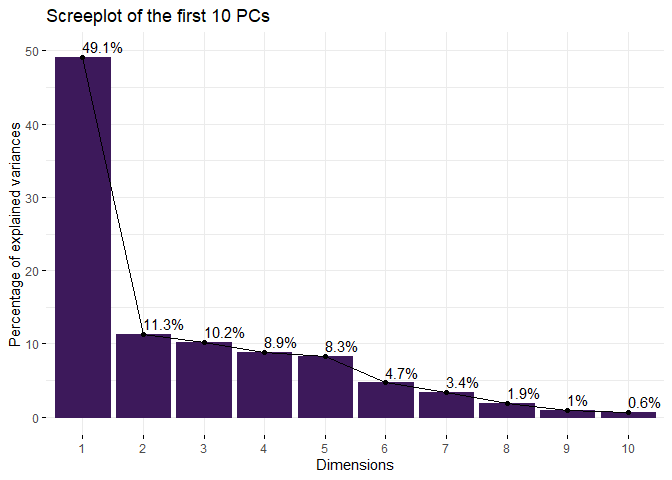
The first five PCs explain 87.80% of total variance.
Quality of representation
By the below plot, PCs beyond PC5 have little significance to the analysis.
var <- get_pca_var(pca)
corrplot(var$cos2, is.corr = FALSE, method = "square")
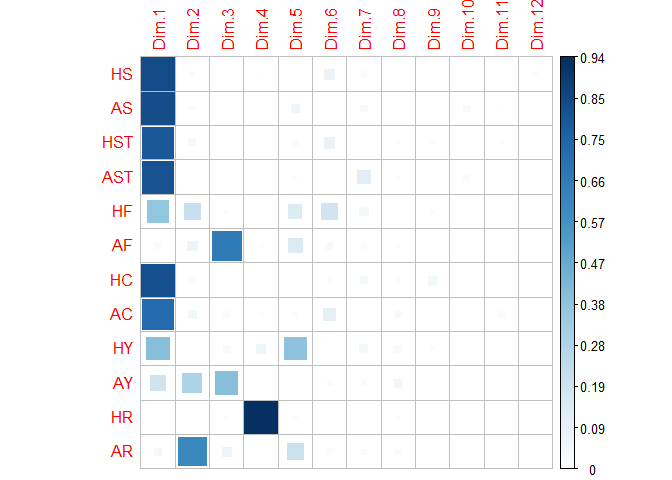
# Total cos2 of variables on PC1 and PC2
fviz_cos2(pca,
choice = "var", axes = 1:2,
title = "Sum of independent variables in PC1 and PC2",
fill = "#3d195b", color = "#3d195b"
)
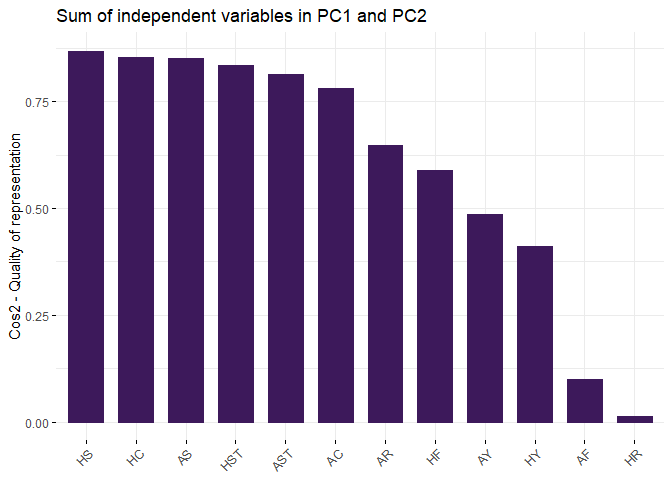
Eignevalues analysis
zapsmall(get_eigenvalue(pca))
## eigenvalue variance.percent cumulative.variance.percent
## Dim.1 5.89234 49.10284 49.10284
## Dim.2 1.35679 11.30657 60.40941
## Dim.3 1.22427 10.20226 70.61167
## Dim.4 1.06452 8.87100 79.48267
## Dim.5 0.99838 8.31979 87.80246
## Dim.6 0.56086 4.67387 92.47634
## Dim.7 0.41181 3.43174 95.90808
## Dim.8 0.22215 1.85124 97.75932
## Dim.9 0.11579 0.96488 98.72421
## Dim.10 0.07381 0.61511 99.33932
## Dim.11 0.06249 0.52078 99.86010
## Dim.12 0.01679 0.13990 100.00000
Since the eigenvalues beyond PC5 are significantly less than 1, according to Kaiser Rule, which mean they are explaining less variance than one independent variable. Therefore, total 5 PCs will be used.
Contribution for loadings of each PC
(zapsmall(var$contrib[, 1:5]))
## Dim.1 Dim.2 Dim.3 Dim.4 Dim.5
## HS 14.38937 1.51669 0.02446 0.53439 0.78434
## AS 14.13506 1.40576 0.00005 0.01467 5.86522
## HST 13.50251 2.83039 0.12417 0.37533 2.69839
## AST 13.75937 0.16770 0.56088 0.12155 0.95727
## HF 6.36282 15.78376 0.77463 0.30650 13.88877
## AF 0.46109 5.30076 53.92940 1.46386 14.90660
## HC 14.03100 1.98957 0.09251 0.65872 0.00659
## AC 12.42937 3.62713 2.10217 1.06416 1.07972
## HY 6.87327 0.42215 2.87897 6.26729 37.96259
## AY 3.33618 21.41235 32.88986 0.66215 0.19191
## HR 0.07654 0.63199 1.02227 88.50718 1.05281
## AR 0.64341 44.91173 5.60064 0.02419 20.60579
The 1/12 of 8.125% level is represented by the red dash line.
# Contributions of variables to PC1
fviz_contrib(pca, choice = "var", axes = 1, top = 12, fill = "#3d195b", color = "#3d195b")
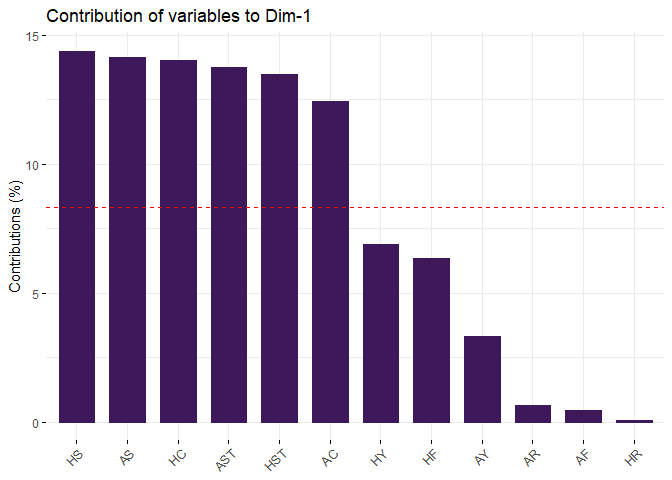
PC1 is attacked related, as high loadings are Home Team Shots, Away Team Shots, Home Team Shots on Target, Away Team Shots on Target, Home Team Corners and Away Team Corners, which explains 49.10% of variance. It is reasonable as attack is the best way to win a game in soccer, so as to explaining the game.
# Contributions of variables to PC2
fviz_contrib(pca, choice = "var", axes = 2, top = 12, fill = "#3d195b", color = "#3d195b")
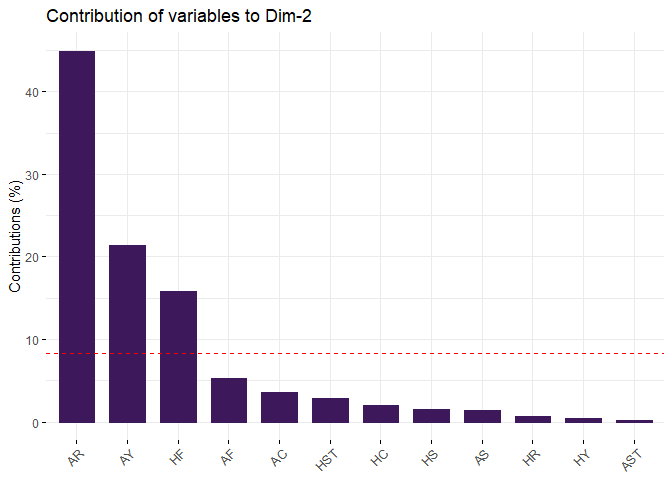
PC2 is a referre statistics, which seems referre related issue since both Home and Away Team are involved in the statistics. Major contributions are Home Team Fouls Committed, Away Team Yellow Cards and Away Team Red Cards. PC3 explains 11.31% variance.
# Contributions of variables to PC3
fviz_contrib(pca, choice = "var", axes = 3, top = 12, fill = "#3d195b", color = "#3d195b")
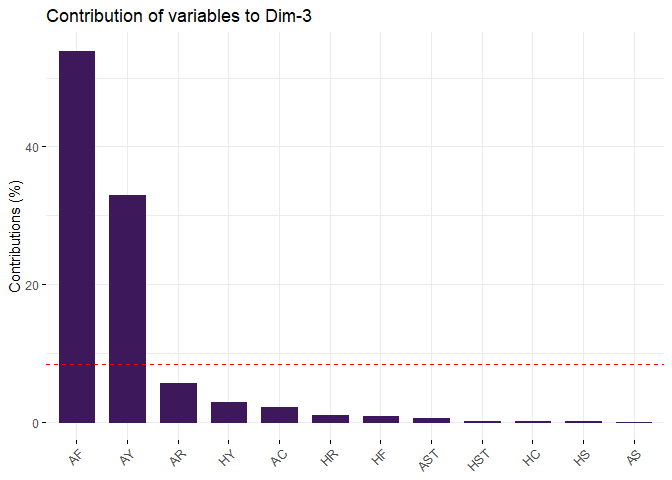
PC3 is Away Team foul play statistics. High loadings are Away Team Fouls Committed and Away Team Yellow Cards. PC3 explains 10.20% variance.
# Contributions of variables to PC4
fviz_contrib(pca, choice = "var", axes = 4, top = 12, fill = "#3d195b", color = "#3d195b")
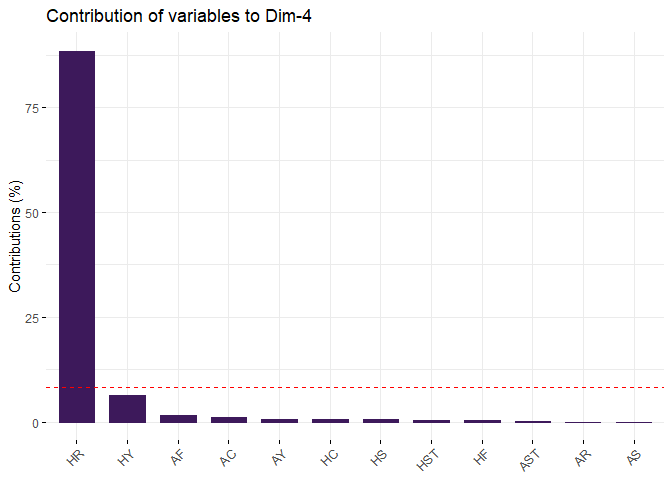
PC4 is Home Team Red Cards statistics. PC4 explains 8.87% variance.
# Contributions of variables to PC5
fviz_contrib(pca, choice = "var", axes = 5, top = 12, fill = "#3d195b", color = "#3d195b")

PC5 seems representing Home Team Advantage. The reason is the loadings of Home Team Fouls Committed and Away Team Fouls Committed are similar, but Away Team Red Cards is much higher than Home Team Yellow Cards. PC5 explains 8.32% variance. The correlation circle in Section 4.1provides graphical repsentation of this PC.
Scatter plot
score1 <- pca$x[, 1:5]
pairs(score1)
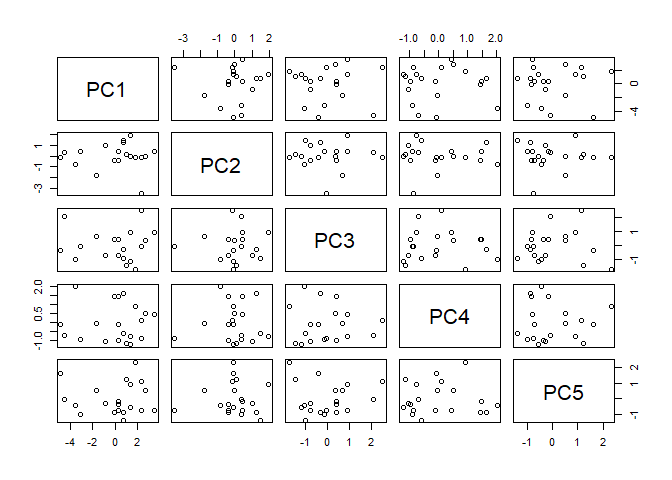
Findings
Correlation circle
The correlation between a variable and a principal component (PC) is used as the coordinates of the variable on the PC. The representation of variables differs from the plot of the observations: The observations are represented by their projections, but the variables are represented by their correlations (Abdi and Williams 2010).
fviz_pca_var(pca,
col.var = "cos2",
gradient.cols = c("black", "blue", "red"),
repel = TRUE # Avoid text overlapping
)
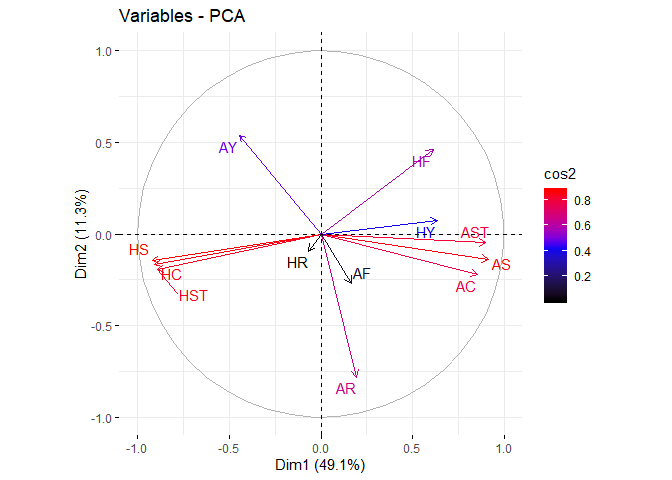
From the plot, positive correlated variables will group together. ‘Attack’ attributes are grouped together.
One interesting observation is home team fouls are positively related to yellow cards while negative related to red cards. Away teams are vice versa. This can be easily related to home advantage of field games. Referees may be more inclined to give minor punishment to home team while away teams have higher chance to get red cards for foul play. This is a strong support to PC5.
Quality and contribution
Below is a series of plots showing each club contribution in PCs
fviz_contrib(pca,
choice = "ind",
axes = 1,
fill = "#3d195b",
color = "#3d195b",
title = "Total Contribution of clubs to PC1"
)
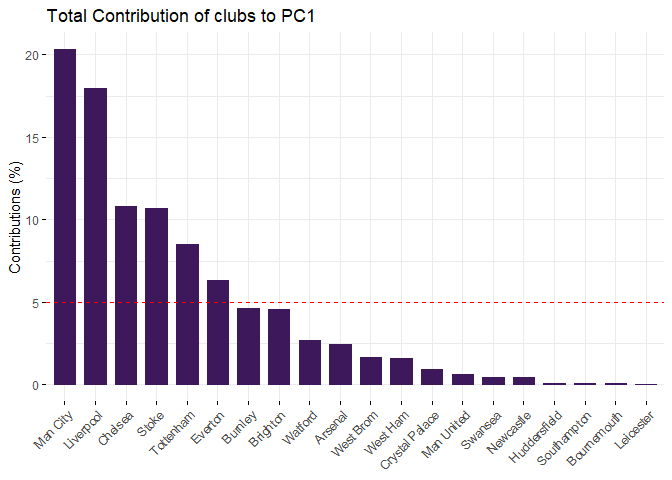
fviz_contrib(pca,
choice = "ind",
axes = 2,
fill = "#3d195b",
color = "#3d195b",
title = "Total Contribution of clubs to PC2"
)
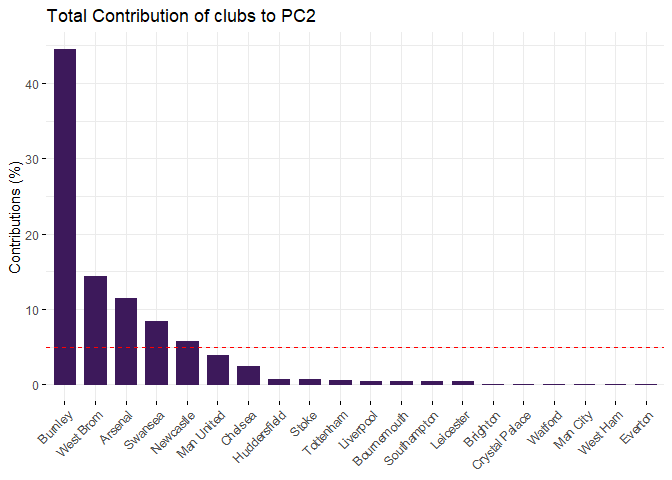
fviz_contrib(pca,
choice = "ind",
axes = 3,
fill = "#3d195b",
color = "#3d195b",
title = "Total Contribution of clubs to PC3"
)
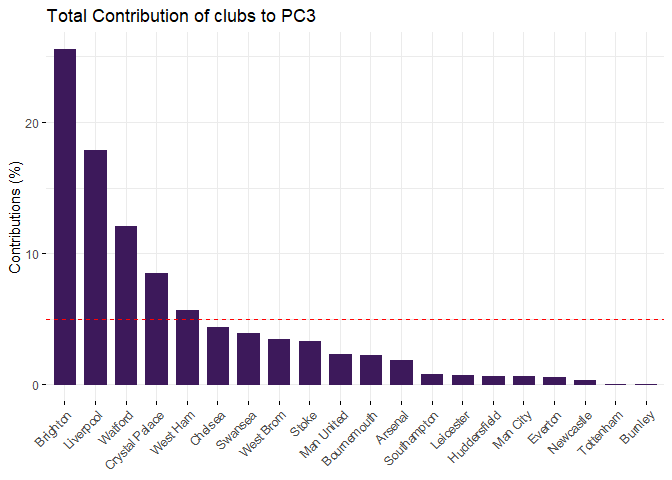
fviz_contrib(pca,
choice = "ind",
axes = 4,
fill = "#3d195b",
color = "#3d195b",
title = "Total Contribution of clubs to PC4"
)
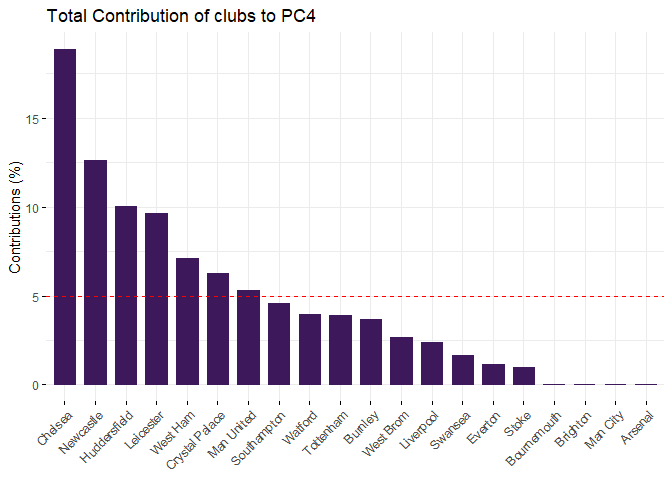
fviz_contrib(pca,
choice = "ind",
axes = 5,
fill = "#3d195b",
color = "#3d195b",
title = "Total Contribution of clubs to PC5"
)
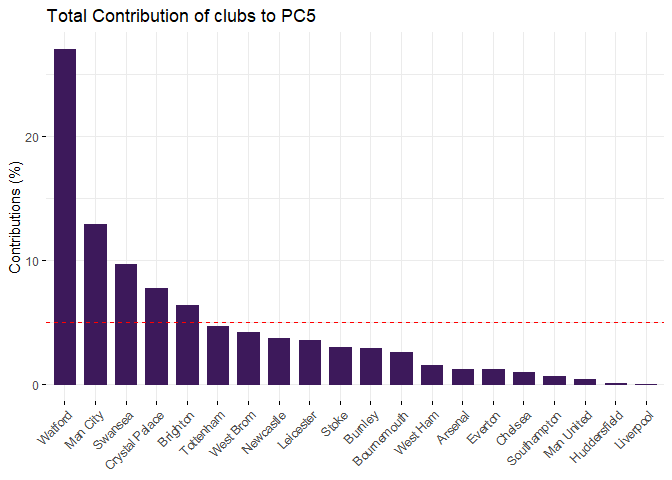
Biplot
Biplot is a combination of row data to PCs. Biplot visualize the data by assigning the PC1 and PC2 to X and Y Axis of Scatter chart like below.
fviz_pca_biplot(pca,
repel = TRUE,
col.var = "blue", # Variables color
col.ind = "#3d195b" # Individuals color
)
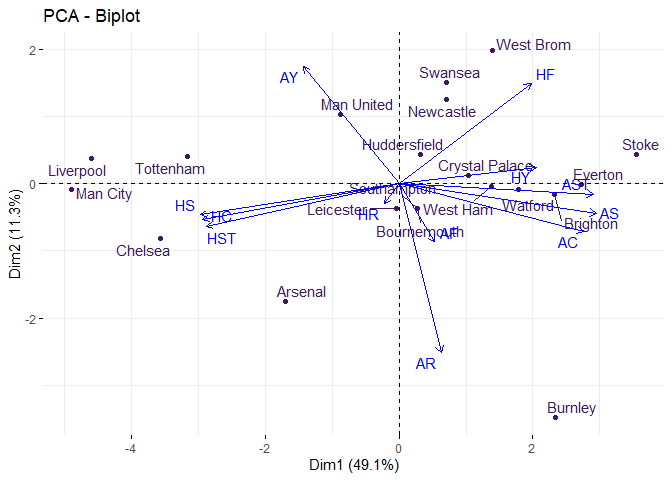 Blue arrows start from origin are
variables. Each club is shown as dot coming from the original rows.
Blue arrows start from origin are
variables. Each club is shown as dot coming from the original rows.
From the analysis, below are some major findings.
-
Manchester City and Chelsea are high in PC1, which translated to good home performance. Final standings of Chelsea was 5 and Manchester City was the champion. So strong home performance is a must in winning the league.
-
Low number in Foul can divide the club ranking. Left side clubs, Liverpool, Tottenham, Manchester City, Chelsea and Arsenal, are top 6 in final ranking. Manchester United seems an outliner in the elite group as it was the first runner-up but located at the middle of PC1. North-east region clubs, including West Bromwich Albion, Swansea City and Stoke City are high in PC2 which means more foul. Stoke City got high Home Yellow Cards too. Besides, these three teams are not good in both Home and Away attacks. According to the final ranking, these three teams performed worse and relegated in Season 2018-2019.
Loadings
(Loadings <- pca$rotation[, 1:5] %>%
round(2) %>%
data.frame() %>%
mutate(Attribute = rownames(.)) %>%
select(Attribute, everything()) %>%
arrange(PC1))
## Attribute PC1 PC2 PC3 PC4 PC5
## 1 HS -0.38 -0.12 -0.02 -0.07 0.09
## 2 HST -0.37 -0.17 0.04 -0.06 0.16
## 3 HC -0.37 -0.14 -0.03 -0.08 -0.01
## 4 AY -0.18 0.46 -0.57 0.08 0.04
## 5 HR -0.03 -0.08 -0.10 0.94 0.10
## 6 AF 0.07 -0.23 -0.73 -0.12 -0.39
## 7 AR 0.08 -0.67 -0.24 0.02 0.45
## 8 HF 0.25 0.40 -0.09 0.06 0.37
## 9 HY 0.26 0.06 -0.17 -0.25 0.62
## 10 AC 0.35 -0.19 0.14 0.10 -0.10
## 11 AST 0.37 -0.04 -0.07 -0.03 -0.10
## 12 AS 0.38 -0.12 0.00 -0.01 -0.24
Plot time series of the Index by the clubs
d$PC1 <- pca$x[, 1]
d$PC2 <- pca$x[, 2]
d %>%
ggplot() +
geom_line(aes(x = as.Date(Date), y = PC1, group = 1), show.legend = F, colour = "#3d195b") +
geom_hline(yintercept = 0, colour = "red") +
facet_wrap(~HomeTeam) +
labs(
x = "Date",
y = "PC1",
title = "PC1 time series by clubs"
) +
theme(axis.text.x = element_text(angle = 90, hjust = 1)) +
scale_x_date(date_labels = "%Y (%b)")
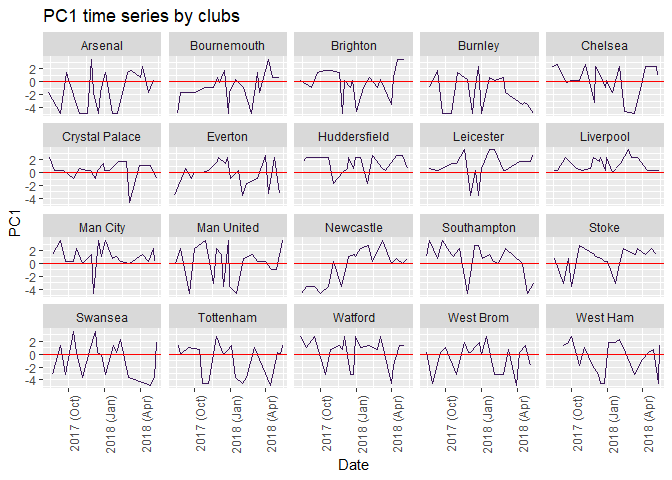
Manchester City kept PC1 mean above 0 all the time.
d %>%
ggplot() +
geom_line(aes(x = as.Date(Date), y = PC2, group = 1), show.legend = F, colour = "#3d195b") +
geom_hline(yintercept = 0, colour = "red") +
facet_wrap(~HomeTeam) +
labs(
x = "Date",
y = "PC2",
title = "PC2 time series by clubs"
) +
theme(axis.text.x = element_text(angle = 90, hjust = 1)) +
scale_x_date(date_labels = "%Y (%b)")
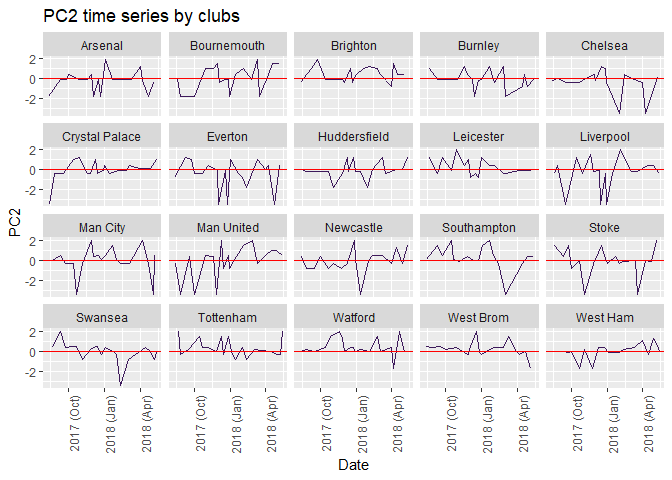
Mean of PC1 and PC2
d %>%
group_by(HomeTeam) %>%
summarise(
Index.1 = mean(PC1),
Index.2 = mean(PC2)
) %>%
arrange(desc(Index.1)) %>%
select(HomeTeam, Index.1, Index.2)
## # A tibble: 20 x 3
## HomeTeam Index.1 Index.2
## <chr> <dbl> <dbl>
## 1 Huddersfield 1.37 -0.0243
## 2 Liverpool 1.27 -0.333
## 3 Man City 1.00 -0.0720
## 4 Leicester 0.880 0.244
## 5 Southampton 0.673 0.277
## 6 Stoke 0.604 -0.0573
## 7 Watford 0.403 0.428
## 8 Crystal Palace 0.309 -0.0218
## 9 Chelsea 0.248 -0.418
## 10 Man United 0.0243 -0.123
## 11 Brighton -0.0300 0.437
## 12 Everton -0.193 -0.498
## 13 West Ham -0.429 0.00177
## 14 West Brom -0.441 0.175
## 15 Newcastle -0.483 -0.0838
## 16 Swansea -0.725 -0.0748
## 17 Tottenham -0.766 0.348
## 18 Bournemouth -0.880 0.0496
## 19 Arsenal -1.21 -0.221
## 20 Burnley -1.62 -0.0335
Rolling mean of PC1 and PC2
d %<>% group_by(HomeTeam) %>%
arrange(Date) %>%
mutate(
M.A.PC1 = rollmeanr(PC1, 15, fill = NA),
M.A.PC2 = rollmeanr(PC2, 15, fill = NA)
)
Index.1718 <- d %>%
group_by(HomeTeam) %>%
filter(Date == max(Date)) %>%
select(HomeTeam, M.A.PC1, M.A.PC2, Date) %>%
arrange(M.A.PC1)
ggplot(Index.1718, aes(x = M.A.PC1, y = M.A.PC2)) +
geom_point(show.legend = F, colour = "#3d195b", size = 5) +
geom_text(aes(label = HomeTeam),
check_overlap = TRUE, nudge_y = 0.08,
show.legend = F, size = 2.9
) +
labs(x = "PC1", y = "PC2")
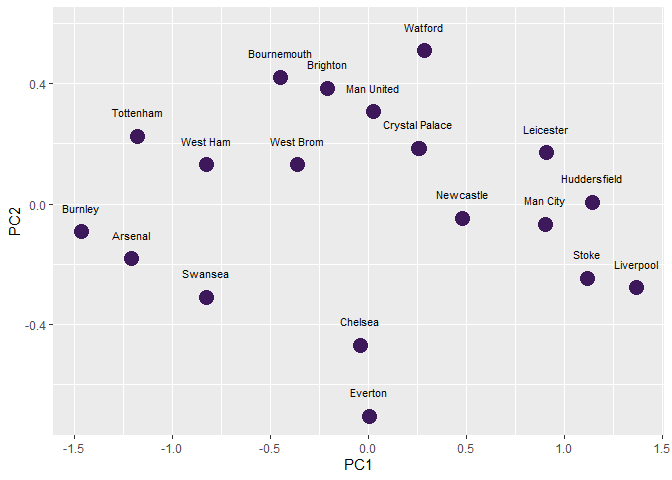
Away Team Analysis
For complete demonstration, Away Team PCA is carried out as below.
d2 <- d %>%
group_by(AwayTeam) %>%
summarise(
HS = sum(HS),
AS = sum(AS),
HST = sum(HST),
AST = sum(AST),
HF = sum(HF),
AF = sum(AF),
HC = sum(HC),
AC = sum(AC),
HY = sum(HY),
AY = sum(AY),
HR = sum(HR),
AR = sum(AR)
)
away.df <- column_to_rownames(d2, var = "AwayTeam")
(away.df)
## HS AS HST AST HF AF HC AC HY AY HR AR
## Arsenal 238 250 79 87 194 197 86 93 25 32 2 1
## Bournemouth 292 199 91 75 232 172 126 102 37 24 0 0
## Brighton 312 166 94 47 141 215 130 73 13 17 1 1
## Burnley 299 172 84 61 214 183 130 73 27 38 2 0
## Chelsea 209 250 69 88 195 180 89 82 40 22 0 1
## Crystal Palace 256 208 95 60 199 210 113 105 34 33 1 0
## Everton 301 171 102 62 187 225 113 69 23 23 3 2
## Huddersfield 255 153 88 56 197 216 126 63 23 35 3 1
## Leicester 274 195 99 73 172 185 127 91 24 30 0 3
## Liverpool 164 281 66 98 163 178 64 96 21 26 0 1
## Man City 132 317 47 110 186 175 56 146 36 32 1 1
## Man United 260 238 81 88 216 200 100 103 35 35 1 1
## Newcastle 261 225 92 79 184 202 128 84 27 29 0 0
## Southampton 270 199 96 68 197 226 112 102 25 34 1 2
## Stoke 314 179 123 66 194 217 153 56 26 32 0 0
## Swansea 316 122 105 35 201 181 114 55 28 27 0 1
## Tottenham 184 269 64 97 205 207 89 103 39 29 1 2
## Watford 204 204 79 62 187 217 106 88 27 22 0 2
## West Brom 286 165 89 49 193 210 89 75 25 37 1 1
## West Ham 335 162 115 69 226 186 130 68 27 38 0 2
summary(away.df)
## HS AS HST AST
## Min. :132.0 Min. :122.0 Min. : 47.00 Min. : 35.00
## 1st Qu.:230.8 1st Qu.:169.8 1st Qu.: 79.00 1st Qu.: 60.75
## Median :265.5 Median :199.0 Median : 90.00 Median : 68.50
## Mean :258.1 Mean :206.2 Mean : 87.90 Mean : 71.50
## 3rd Qu.:299.5 3rd Qu.:241.0 3rd Qu.: 96.75 3rd Qu.: 87.25
## Max. :335.0 Max. :317.0 Max. :123.00 Max. :110.00
## HF AF HC AC
## Min. :141.0 Min. :172.0 Min. : 56.0 Min. : 55.00
## 1st Qu.:186.8 1st Qu.:182.5 1st Qu.: 89.0 1st Qu.: 72.00
## Median :194.5 Median :201.0 Median :113.0 Median : 86.00
## Mean :194.2 Mean :199.1 Mean :109.0 Mean : 86.35
## 3rd Qu.:202.0 3rd Qu.:215.2 3rd Qu.:127.2 3rd Qu.:102.00
## Max. :232.0 Max. :226.0 Max. :153.0 Max. :146.00
## HY AY HR AR
## Min. :13.00 Min. :17.00 Min. :0.00 Min. :0.00
## 1st Qu.:24.75 1st Qu.:25.50 1st Qu.:0.00 1st Qu.:0.75
## Median :27.00 Median :31.00 Median :1.00 Median :1.00
## Mean :28.10 Mean :29.75 Mean :0.85 Mean :1.10
## 3rd Qu.:34.25 3rd Qu.:34.25 3rd Qu.:1.00 3rd Qu.:2.00
## Max. :40.00 Max. :38.00 Max. :3.00 Max. :3.00
ggplot(stack(away.df), aes(x = ind, y = values)) +
geom_boxplot(fill = "#3d195b", colour = "red") +
labs(
x = "Variables",
y = "Values",
title = "Boxplot for 12 variables"
)
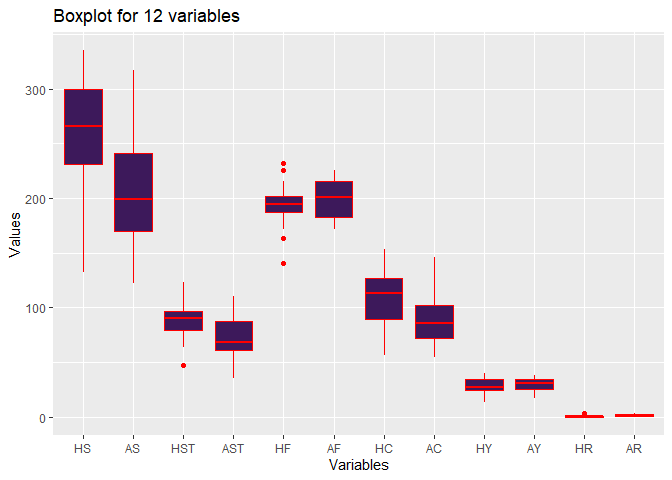
pca2 <- prcomp(away.df, center = TRUE, scale = TRUE)
summary(pca2)
## Importance of components:
## PC1 PC2 PC3 PC4 PC5 PC6 PC7
## Standard deviation 2.3100 1.4542 1.1921 0.96504 0.81775 0.76849 0.59752
## Proportion of Variance 0.4447 0.1762 0.1184 0.07761 0.05573 0.04922 0.02975
## Cumulative Proportion 0.4447 0.6209 0.7393 0.81692 0.87264 0.92186 0.95161
## PC8 PC9 PC10 PC11 PC12
## Standard deviation 0.53131 0.38977 0.30503 0.22007 0.07058
## Proportion of Variance 0.02352 0.01266 0.00775 0.00404 0.00042
## Cumulative Proportion 0.97514 0.98780 0.99555 0.99958 1.00000
fviz_pca_var(pca2,
col.var = "cos2",
gradient.cols = c("black", "blue", "red"),
repel = TRUE # Avoid text overlapping
)
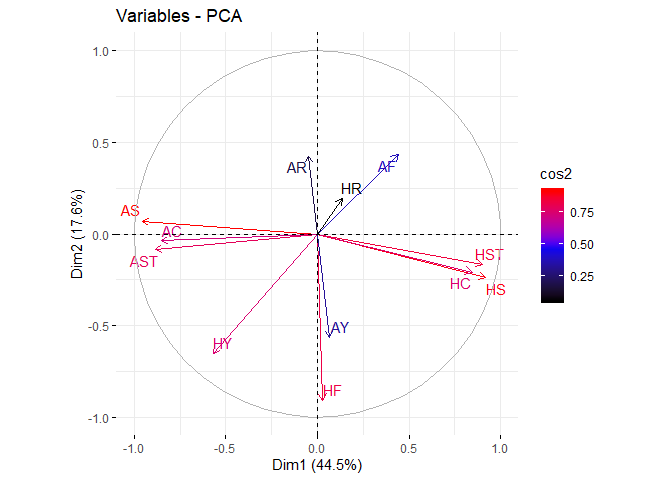
d$PC1a <- pca2$x[, 1]
d$PC2a <- pca2$x[, 2]
d %>%
ggplot() +
geom_line(aes(x = as.Date(Date), y = PC1a, group = 1), show.legend = F, colour = "#3d195b") +
geom_hline(yintercept = 0, colour = "red") +
facet_wrap(~HomeTeam) +
labs(
x = "Date",
y = "PC1a",
title = "PC1a time series by clubs (Away)"
) +
theme(axis.text.x = element_text(angle = 90, hjust = 1)) +
scale_x_date(date_labels = "%Y (%b)")
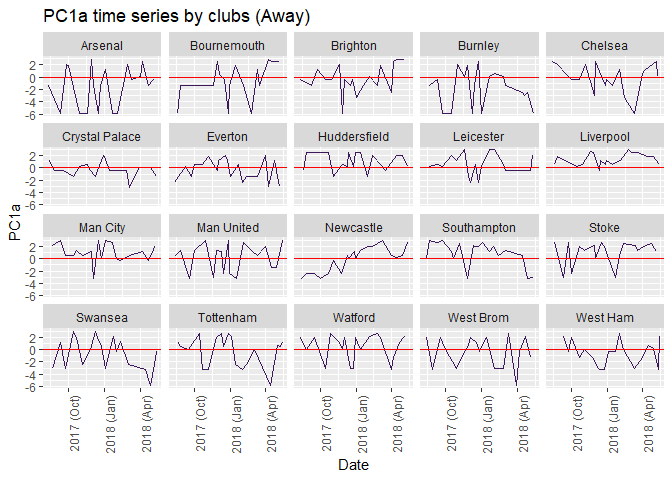
d %>%
ggplot() +
geom_line(aes(x = as.Date(Date), y = PC2a, group = 1), show.legend = F, colour = "#3d195b") +
geom_hline(yintercept = 0, colour = "red") +
facet_wrap(~AwayTeam) +
labs(
x = "Date",
y = "PC2a",
title = "PC2a time series by clubs (Away)"
) +
theme(axis.text.x = element_text(angle = 90, hjust = 1)) +
scale_x_date(date_labels = "%Y (%b)")
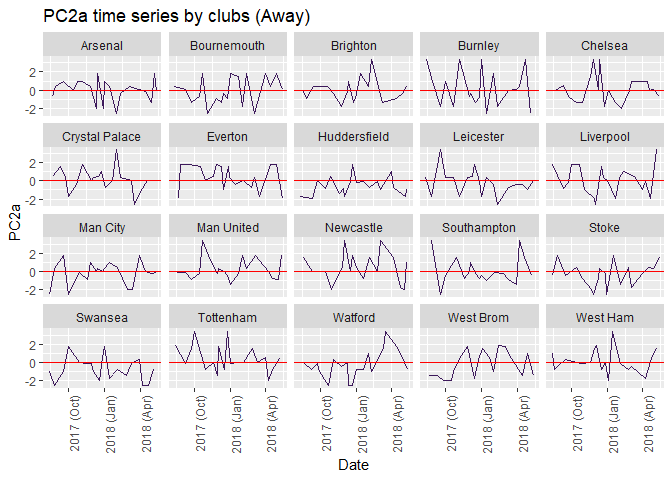
d %>%
group_by(AwayTeam) %>%
summarise(
Index.1 = mean(PC1a),
Index.2 = mean(PC2a)
) %>%
arrange(desc(Index.1)) %>%
select(AwayTeam, Index.1, Index.2)
## # A tibble: 20 x 3
## AwayTeam Index.1 Index.2
## <chr> <dbl> <dbl>
## 1 Arsenal 0.445 -0.0215
## 2 Burnley 0.414 0.212
## 3 Tottenham 0.365 0.442
## 4 Man City 0.274 -0.158
## 5 Swansea 0.242 -0.695
## 6 Huddersfield 0.216 -0.569
## 7 West Brom 0.206 -0.238
## 8 Brighton 0.156 0.000481
## 9 Chelsea 0.134 0.0689
## 10 Watford 0.0281 -0.242
## 11 Southampton -0.0171 0.109
## 12 Newcastle -0.0298 0.464
## 13 Leicester -0.0617 -0.166
## 14 Stoke -0.127 -0.283
## 15 Man United -0.153 0.351
## 16 West Ham -0.180 0.154
## 17 Liverpool -0.185 0.0610
## 18 Everton -0.404 0.379
## 19 Crystal Palace -0.491 0.204
## 20 Bournemouth -0.830 -0.0703
Huddersfield Town[3] is an outliner. Final standing was not high but got good home performance. Part of the reasons maybe the turnaround matches in the League, which drew big clubs like Chelsea and Manchester United.
Conclusion
Principal componenet analysis can sort out the winning elements and help club managers to run their clubs.
Principal component analysis can represent infomration in a lower dimension which can make analysis easier to handle and find out different aspects of factors. If analysers focus on first few PCs, they can make a model with better performance.
Reference
-
Applied Multivariate Statistical Analysis, 5th ed., Richard Johnson and Dean Wichern, Prentice Hall.
-
Principal Component Analysis (PCA) 101, using R, Peter Nistrup, https://towardsdatascience.com/principal-component-analysis-pca-101-using-r-361f4c53a9ff
-
Principal Component Analysis in R: prcomp vs princomp, Statistical tools for high-throughput data analysis, http://www.sthda.com/english/articles/31-principal-component-methods-in-r-practical-guide/118-principal-component-analysis-in-r-prcomp-vs-princomp/
-
How to rate the performance of a soccer team? An application of Principal Components Analysis, https://fcostartistician.wordpress.com/2017/05/22/how-to-rate-the-performance-of-a-soccer-team-an-application-of-principal-components-analysis/
-
Principal Component Analysis (PCA) with FactoMineR(decathlon dataset)François Husson & Magalie Houée-Bigot, http://factominer.free.fr/course/doc/RMarkdown_PCA_Decathlon.pdf
-
Principal Component Analysis, 2nd ed., I.T. Jolliffe, Springer.
[1] Leading: Learning from Life and My Years at Manchester United by Alex Ferguson, Michael Moritz (With). ISBN 9780316268080
tags: test - PCA